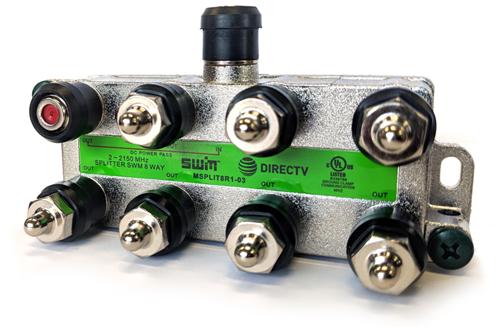This one comes from the installer community. An installer asked us,
I’m replacing an outdated apartment CATV system with DIRECTV. The closet isn’t completely weatherproof. Should I put the new trunk equipment in an enclosure to keep out dust and bugs?
Let’s unpack what they’re saying
So, if you’re not familiar with the jargon, CATV is cable television. The closet they’re talking about is probably a master distribution closet, where other electrical equipment for the complex is kept. Trunk equipment, in this case, means the amplifiers, taps, and multiswitches that help the satellite signal get to so many apartments.
Cool? So here’s the answer.
Generally an enclosure isn’t necessary.
AT&T’s satellite equipment isn’t waterproof, but it is weather-resistant. You’ll notice that most AT&T equipment comes with weather boots to protect the connection. They’re the black things on the ports of this splitter:

If you are using equipment that doesn’t come with weather boots like our STA trunk amplifier, you can add them if you are concerned. You can get them at Solid Signal of course. As a general rule, equipment that comes with weather boots is good for a mixed environment where it’s not getting rained on directly (such as under an eave) while equipment that doesn’t come with weather boots should be inside if possible. However, as I said all AT&T equipment is at least weather resistant. Don’t splash it or drop it in a pool but a little moisture will probably be ok on the rare occasion.
Should you worry about dust?
Generally dust incursion is not an issue with AT&T equipment. I have seen this stuff work for years in dusty areas and keep working when it is so crusted over that you can’t even read the model number. I’m not saying that’s the best situation, only that you shouldn’t worry about it. The worst case scenario is that the dust slows the heat dissipation and the device runs a bit hotter.
Most AT&T equipment is rated to run perfectly fine between 40 and 110 degrees Fahrenheit. Passive equipment like taps and splitters can work far outside that range.
The problem with enclosures
Speaking of heat dissipation, that’s the real problem with enclosures. By keeping airflow to a minimum, an enclosure will cause your equipment to run hotter. If it runs too hot it will shut down or fail prematurely. Most enclosures have no venting whatsoever.
If you do need to use an enclosure, consider a vented one and make sure there is plenty of room on all sides for the equipment. Vented enclosures are going to be a lot more expensive than your average “plastic box” and so you might prefer to avoid them and just find a different place to put your stuff.
Luckily as I said this sort of thing is really not needed in most scenarios. Just do regular inspections in the equipment closets and look for cases where water is getting in. Best case scenario, try to avoid dust but don’t worry about having a “clean room environment.” AT&T equipment works just fine in the real world.
And, of course, when you’re shopping for satellite equipment — even commercial-grade stuff — make sure you shop at SolidSignal.com.




